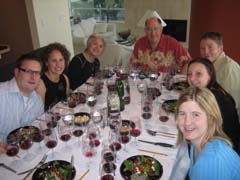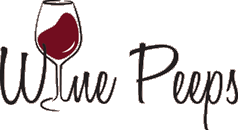Tasting Methodology
By Kori ~ June 9th, 2008.
“Wine tasting is to taste a wine with care in order to appreciate its quality; to submit it to examination by our senses, in particular those of taste and smell; to try and understand it by discovering its various qualities and defects and putting them into words….†–Jean Ribereau-Gayon and Emile Peynaud
 As you begin to examine each wine in a tasting you attend or host, try to follow the tasting methodology below (adapted from several sources over the years, including the Wine Spectator, Emile Peynaud, and Amy Mumma, CWU World Wine Program coordinator) or something similar:
As you begin to examine each wine in a tasting you attend or host, try to follow the tasting methodology below (adapted from several sources over the years, including the Wine Spectator, Emile Peynaud, and Amy Mumma, CWU World Wine Program coordinator) or something similar:
First, pour about 1/3 glassful in an appropriate tasting glass.
SEE: Tilt the glass at a 45-degree angle away from you against a white background with good lighting.
- Is the wine brilliant, clear, or hazy?
- Do you see any bubbles or ropiness?
- Is the color pale or intense (appropriate for the varietal)?
- Does it have good color depth or density?
Sight is the first of our senses that we use in wine tasting. What you see gives you a sneak preview, clues as to what to expect. Be sure to take good notes at each step in seeing, sniffing, and sipping.
SNIFF: Swirl the wine gently in the glass to aerate it and release its bouquet, then put your nose inside the rim of the glass and take a couple of slow, deep sniffs to smell for aromas.
- Is the wine clean, or are there any off-odors?
- Are the aromas faint or intense?
- What are the aromas? Does it smell like fruit, flowers, spice, etc?
- Does the wine smell oaky? (American Oak: overt, vanilla, perception of sweetness; French Oak: subtle, spicy, kicks in mid-palate)
SIP: Take a small amount of wine into your mouth, let it lie on your tongue a few seconds and then slowly draw in some air through your lips, and then swish the liquid around like mouthwash, bringing it into contact with every part of your mouth.
- Is the wine sweet or dry? (<0.5% residual sugar is considered dry)
- Does the wine fill your mouth, i.e. have body? Does it feel more like water (light-bodied) or cream (full-bodied)?
- What are the flavors and are they intense or diluted? (Do they have the subtlety of an Old World wine or the boldness of a New World wine?)
Take another sip and evaluate the acidity, tannins, and alcohol.
- Is there a tingle around the sides or tip of your tongue? Does it have sourness like lemonade (tart), is it flat like water, or something in between (crisp, zesty)? [Signs of high acidity: leaves your mouth initially feeling dry but is soon replaced with significant saliva production.]
- Is there a puckering dryness (astringency), a rough gritty feeling, or even bitterness on your tongue or inner cheeks, like strong iced tea would cause? [Signs of tannins: leaves your mouth feeling dry and cottony.]
- Does the wine taste hot at the back of your mouth? [A sign of alcohol.]
- Are the flavors, acidity, tannins, and alcohol in equilibrium? [A sign of balance.] Too much alcohol and not enough acidity and tannins means a wine is soft. Too much acidity and tannins and not enough alcohol means a wine is harsh. A balanced wine will become smooth and integrated as it matures.
- Do you find something new in the wine each time you come back to it? Do you taste a number of different flavors? [Signs of complexity.]
SUMMARIZE: Spit or swallow the wine and record your impressions. After you spit or swallow, you can close your mouth and breathe out through your nose for further evaluation of the wine.
- Is it free of measurable wine faults? (ex. musty, baked, vinegary, sulfur, etc.)
- How long after you swallow do the flavors linger? (Finish, sometimes also called Length.) A finish of <5 seconds is short, 5-9 seconds is moderate, 10-15 seconds is long, and 15+ seconds is lingering. The longer the finish, the better.
- What is the wine’s overall quality?
- Do you like the wine personally?
- How would you describe the wine in one sentence? Try to make your one word sentence not just “I like it†or “I don’t like it†but more a description of what you like or don’t like about the wine. It doesn’t have to include any fancy wine-speak, just a simple sentence like “This wine is not balanced; I’d prefer a wine with more fruit and less alcohol.â€
- And, finally, keep written tasting records. You’ll find it valuable and entertaining to look back on in the future.
The true wine experience encompasses all five senses, including hearing as you listen and appreciate the sounds of your friends and family drinking good wine with you and celebrating the day.
Filed under: General Wine Information

 Wine Peeps is an independent wine blog dedicated to helping you get the most bang for your buck in wine. We do this through blind tastings of wine from around the world and calculations of
Wine Peeps is an independent wine blog dedicated to helping you get the most bang for your buck in wine. We do this through blind tastings of wine from around the world and calculations of 










